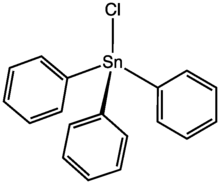This is the current revision of this page, as edited by DreamRimmer (talk | contribs) at 15:57, 3 May 2023 (clean up, typo(s) fixed: a antifeedants → an antifeedants). The present address (URL) is a permanent link to this version.
Revision as of 15:57, 3 May 2023 by DreamRimmer (talk | contribs) (clean up, typo(s) fixed: a antifeedants → an antifeedants)(diff) ← Previous revision | Latest revision (diff) | Newer revision → (diff)
| |

| |
| Names | |
|---|---|
| IUPAC name chlorotriphenylstannane | |
| Identifiers | |
| CAS Number | |
| 3D model (JSmol) | |
| ChEMBL | |
| ChemSpider | |
| ECHA InfoCard | 100.010.327 |
| PubChem CID | |
| UNII | |
| CompTox Dashboard (EPA) | |
InChI
| |
SMILES
| |
| Properties | |
| Chemical formula | C18H15ClSn |
| Molar mass | 385.4747 g/mol |
| Appearance | colourless solid |
| Melting point | 108 °C (226 °F; 381 K) |
| Boiling point | 240 °C (464 °F; 513 K) |
| Solubility in water | organic solvents |
| Except where otherwise noted, data are given for materials in their standard state (at 25 °C , 100 kPa).
| |
Triphenyltin chloride is an organotin compound with formula Sn(C6H5)3Cl. It is a colourless solid that dissolves in organic solvents. It slowly reacts with water. The main use for this compound is as a fungicide and antifoulant. Triphenyl tin chloride is used as a chemosterilant. Triphenyl tins used as an antifeedants against potato cutworm.
Hazards
Triphenyltin chloride is as toxic as hydrogen cyanide. It also caused detrimental effects on body weight, testicular size and structure, and decreased fertility in Holtzmann rats.
References
- Davies, A. G. (2004). Organotin Chemistry. Weinheim, Germany: Wiley-VCH. ISBN 3-527-31023-1.
- G. G. Graf (2005). "Tin, Tin Alloys, and Tin Compounds". Ullmann's Encyclopedia of Industrial Chemistry. Weinheim: Wiley-VCH. doi:10.1002/14356007.a27_049. ISBN 3527306730.
- Golub, M. S. (2006). Metals, Fertility, and Reproductive Toxicity. CRC Press. pp. 28–31. ISBN 0-415-70040-X.
This article about an organic compound is a stub. You can help Misplaced Pages by expanding it. |